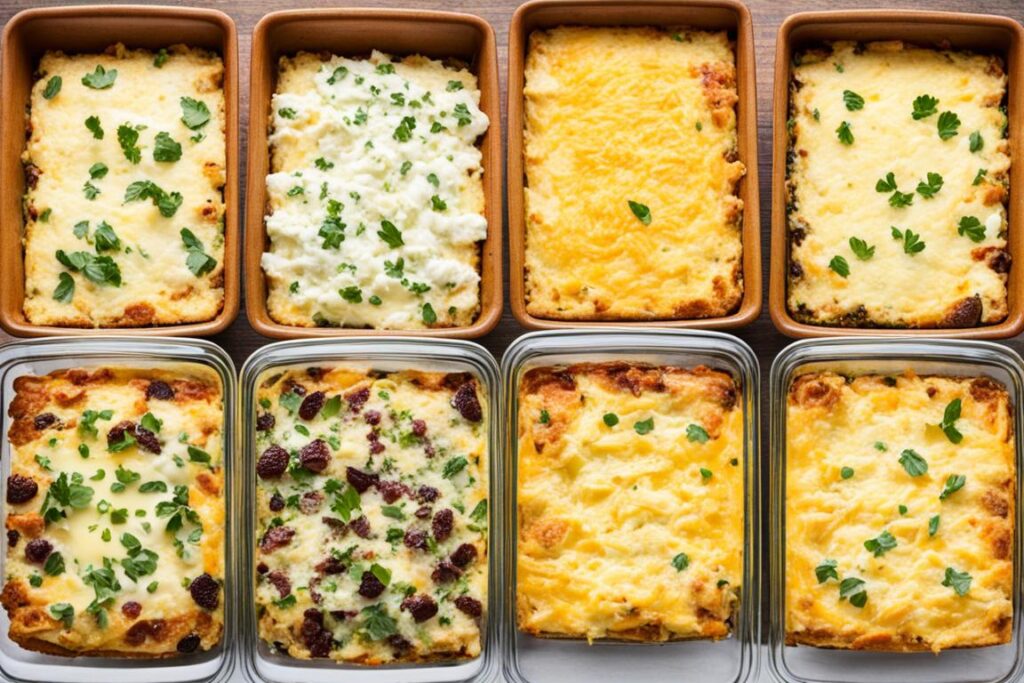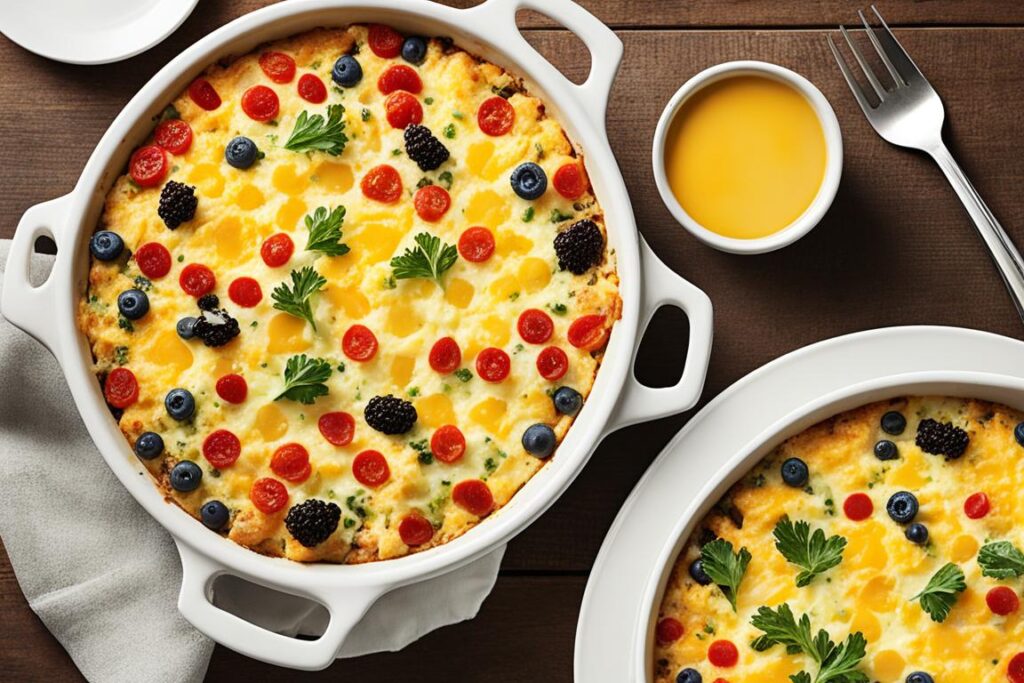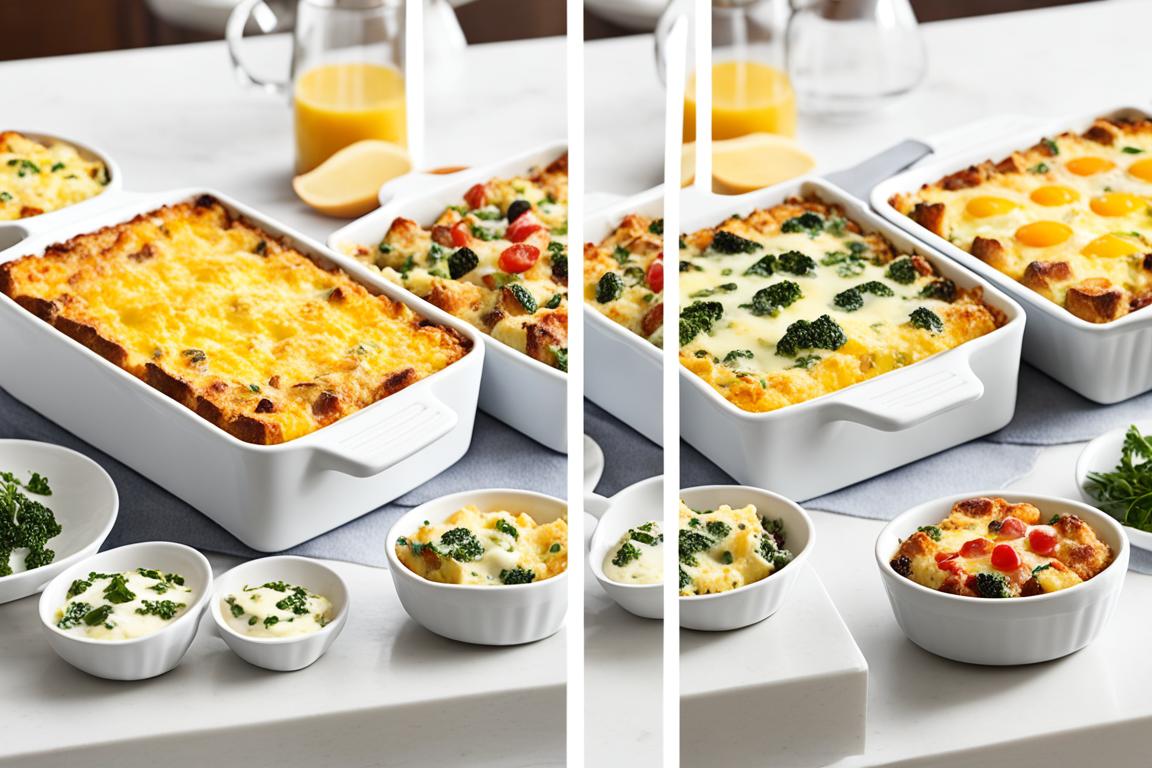Ever wondered why a breakfast casserole and a strata seem so similar yet cause confusion in the kitchen? They’re both great for brunch and family breakfasts, but what makes them different? This article will explore the key differences between these two dishes. By looking at their definitions, ingredients, and how they’re made, you’ll understand the breakfast casserole vs strata debate. Whether you prefer the warmth of a casserole or the elegance of a strata, this will help you improve your cooking skills.
Key Takeaways
- Both dishes serve as hearty breakfast options but have unique characteristics.
- A breakfast casserole typically features a more mixed and baked filling.
- A strata uses layers of bread, eggs, and other ingredients, often allowing for a richer texture.
- Understanding their differences can elevate your breakfast cooking skills.
- Preparation methods vary between the two, impacting cooking time and flavor.
- Both dishes offer excellent make-ahead options for busy mornings.
Introduction to Breakfast Dishes
Learning about breakfast dishes is key to boosting daily nutrition. Breakfast is crucial as it gives us the energy and nutrients we need to start the day. There are many breakfast options available, fitting different tastes, dietary needs, and schedules.
For those in a hurry, quick choices like cereals and smoothies are perfect. But for those who want something more, quiches and frittatas offer a fancy touch. Breakfast casseroles and stratas are great for feeding a crowd or satisfying individual tastes. Trying these dishes helps us appreciate their culinary value.
Exploring different breakfast options reveals not just tasty flavors but also their nutritional benefits. For tips on a balanced breakfast, check out the terms and conditions on recipe websites.
Understanding Breakfast Casseroles
A breakfast casserole is a mix of flavors and textures, perfect for brunch or family meals. It’s easy to make and can be tailored to your taste. The breakfast casserole definition says it has layers of bread, eggs, cheese, and sometimes meat and veggies.
Definition of a Breakfast Casserole
Breakfast casseroles come in many styles, offering a variety of tastes. They’re made by putting ingredients in a dish and baking until they’re done. These meals are filling and great for sharing with others.
Common Ingredients in Breakfast Casseroles
Knowing the breakfast casserole ingredients is key to making a great dish. Some top popular ingredients for casseroles are:
- Eggs
- Bread (or hash browns)
- Cream or milk
- Cheese (such as cheddar or mozzarella)
- Meats like bacon, sausage, or ham
- Vegetables like spinach, bell peppers, or onions
These items add flavor and nutrition to the casserole, making it good for many diets.
Preparation Methods for Breakfast Casseroles
Cooks often layer ingredients in a casserole dish when preparing breakfast casseroles. This lets the egg soak into the bread and other parts, creating rich flavors. Many recipes suggest making the dish the night before, letting it chill in the fridge. Then, cooking breakfast casseroles the next day makes the flavors even better.
Exploring Stratas
A strata is a tasty breakfast choice that combines ease with flavor. It’s a savory egg-bread casserole, often called a “breakfast casserole.” This dish features a mix of bread and eggs with various fillings. Knowing about breakfast strata can make any breakfast special, perfect for family meals or lazy weekends.
What is a Strata?
A strata is a layered dish made from stale or day-old bread, eggs, and milk. This mix creates a texture like bread pudding when baked. Chefs love how versatile a strata is, allowing for many fillings and flavors.
Key Components of a Strata
The main ingredients for a strata are:
- Cubes of stale or day-old bread
- Eggs
- Milk or cream
- Fillings such as meats, vegetables, and cheeses
Each ingredient is vital for a strata that’s both filling and full of flavor.
How to Prepare a Strata
Preparing a strata is easy. Begin by layering bread cubes and your chosen fillings in a dish. Then, pour an egg mix with milk over them. A key step is to let it soak overnight, allowing the bread to soak up the egg mixture. This method ensures a dish that’s cohesive and full of flavor, ideal for any breakfast.

What’s the difference between a breakfast casserole and a strata?
The debate between breakfast casserole and strata often comes down to how they are made and what they taste like. Both dishes use eggs, bread, and fillings, but they can be quite different. A strata is a special kind of breakfast casserole. It’s all about layers of egg and bread for a fluffy, rich taste. You can add your favorite meats, cheeses, and veggies to make it your own.
On the other hand, a breakfast casserole is more about mixing different ingredients together easily. You can use everything from potatoes to proteins to make a big, tasty meal with little work. This makes it great for feeding a crowd.
The breakfast casserole strata distinction is key for cooks who want to improve their breakfast game. Knowing the differences helps pick the right dish for the right time. Whether you choose the easy-going casserole or the fancy strata, both are sure to please at breakfast.
| Feature | Breakfast Casserole | Strata |
|---|---|---|
| Definition | Versatile dish with various ingredients | Layered dish primarily of eggs and bread |
| Preparation Style | Quick assembly, often baked | Layering technique, usually prepared overnight |
| Ingredient Variety | Wider range of ingredients, flexible | Focus on specific ingredients, often less variation |
| Serving Size | Typically for larger crowds | Can also feed many but usually tailored |
For more ideas, check out the many breakfast options here. You’ll find delicious stratas and casseroles to try.
Texture and Flavor Profiles
When looking at breakfast options, it’s key to know how a breakfast casserole and a strata differ. Each dish has its own special qualities that can make your meal better. The texture and flavor differences between them are quite interesting.
Texture Comparison
The texture of a breakfast casserole is usually solid and well-blended. This comes from ingredients like bread, meats, and cheese mixing together during cooking. On the other hand, strata has a lighter, custard-like texture. This happens because the bread soaks up the egg mixture, making it fluffy and airy.
Flavor Variations Between Dishes
Breakfast casseroles and stratas have different flavors because of the ingredients used. Casseroles have many layers, so they can have a wide range of tastes. You might find vegetables, cheeses, and meats that add to the flavor. Stratas, however, are simpler, focusing on the bread and eggs. They can still have subtle flavors, like from herbs or cheese.
| Aspect | Breakfast Casserole | Strata |
|---|---|---|
| Texture | Solid, cohesive | Lighter, custardy |
| Flavor Variety | Diverse, multi-layered | Simplistic, focused |
| Ingredient Flexibility | High | Moderate |
Cooking Techniques: Casserole vs. Strata
Both breakfast casseroles and stratas are great for adding variety to your morning meals. Learning how to bake these dishes can make them even better. It helps bring out the flavors and textures of these easy breakfast recipes.
Oven Preparation for Both Dishes
Both dishes need to be baked in the oven at about 350°F. When making a breakfast casserole, layering ingredients is key for even cooking. For strata, letting it soak overnight in the fridge makes it taste and feel better.
Make-Ahead Options
Both casseroles and stratas are great for making ahead. You can put together a breakfast casserole the night before and bake it in the morning. Stratas also work well this way, resting in the fridge to get even more flavor.
Baking Time Differences
Cooking times for casseroles vary based on what you put in them. They usually take 45-60 minutes to cook through. Stratas cook faster, taking 30 to 45 minutes. Checking if they’re done ensures they’re perfect.
| Dishes | Baking Time | Preparation Method | Make-Ahead Capability |
|---|---|---|---|
| Breakfast Casserole | 45-60 minutes | Layering ingredients | Yes, can be prepped in advance |
| Strata | 30-45 minutes | Soaking overnight | Yes, best made ahead of time |
Using these tips makes breakfast easy and delicious. It lets you enjoy tasty meals with little effort.
For those wanting to learn about strata, check out this guide. It has all the steps you need.
Serving Suggestions for Both Dishes
When serving breakfast casserole or strata, how you present it can make a big difference. You can serve them hot straight from the oven for that cozy feeling. Or, you can let them cool a bit for easier cutting. This depends on the event and what you like best.
Think about adding some sides to make these meals even better:
- Fresh fruits like berries, melons, or citrus add a nice touch.
- Yogurt brings a creamy element that goes well with the main dish.
- A bit of hot sauce can spice up both the casserole and the strata.
These dishes are very versatile, making them perfect for brunch or a family breakfast. They’re great whether you’re serving them alone or with other dishes. Serving breakfast casserole or strata can suit many tastes and events.
| Serving Options | Breakfast Casserole | Strata |
|---|---|---|
| Served Hot | Great for family breakfasts or brunch with a warm, comforting feel. | Ideal for special occasions, adding a touch of elegance. |
| Allowed to Cool | Makes for convenient, easy slicing and serving. | Enhances flavors, often improving the overall taste. |
| Common Sides | Yogurt and fresh fruits are popular choices. | Pairs well with salads and light side dishes. |
| Flavor Enhancements | A splash of hot sauce or salsa can add a kick. | Herbs and spices offer a rich depth of flavor. |
Nutritional Considerations
When looking at breakfast casseroles and stratas, the nutritional content matters a lot. Knowing the calories in these dishes helps people make better food choices. Casseroles often have more calories because they include things like cheese and fatty meats. Stratas, on the other hand, are usually lower in calories since they’re made with bread and eggs.
Caloric Differences
The calories in these dishes can vary a lot, depending on what’s in them. A traditional breakfast casserole can have between 300 to 600 calories per serving. This is because of ingredients like sausage and heavy cheeses. Stratas, however, tend to have fewer calories, around 200 to 400 per serving. This is when you use lighter ingredients. It’s good to know the calories in both to pick the best for your diet.
Healthy Ingredient Swaps
There are many ways to make breakfast dishes healthier. Here are some good swaps:
- Use whole grain bread instead of white or enriched bread
- Choose egg whites or low-fat cheese over regular eggs and full-fat cheese
- Add vegetables like spinach, bell peppers, or zucchini to increase fiber
- Use lean proteins such as turkey instead of pork sausage
These changes make the dishes more nutritious and help you avoid too many calories.
Classic Recipes to Try
Exploring breakfast dishes leads to the world of classic recipes. These recipes are great for everyone. They mix creativity with delicious tastes. They also fit many diets, perfect for family meals or gatherings.
Popular Breakfast Casserole Recipes
Breakfast casseroles often combine eggs, sausage, and cheeses. You can add your own twist to these dishes. Here are some top picks:
- Cheesy Potato Casserole with crispy bacon
- Spinach and Feta Breakfast Casserole
- Mexican Breakfast Casserole with chorizo and salsa
These easy casseroles are perfect for brunches. They bring people together over a tasty meal.
Delicious Strata Variations
Strata recipes are great because you can use what you like. They’re perfect for using seasonal produce or leftovers. Here are some tasty options:
- Mushroom and Gruyère Strata
- Tomato, Basil, and Mozzarella Strata
- Smoked Salmon and Dill Strata
These recipes encourage you to try new things. You can make them fit your taste preferences.

Common Myths and Misconceptions
When it comes to breakfast dishes, there are many myths and misconceptions. These can confuse food lovers when they look at sweet vs savory stratas and other breakfast foods. Clearing up these misconceptions helps us understand the wide range of tasty breakfast options.
Are Stratas Always Sweet?
Many think stratas are only sweet because of popular desserts that use similar cooking methods. But, stratas are mostly savory. They mix eggs, cheeses, meats, and veggies. This mix makes them a great savory choice for breakfast, unlike sweet options.
Is a Breakfast Casserole the Same as a Frittata?
People often mix up breakfast casseroles and frittatas, thinking they’re the same. But, they’re not. The breakfast casserole vs frittata debate shows their differences. Frittatas cook in a skillet and are denser. Breakfast casseroles use more ingredients for layers of flavor, making them unique.
| Feature | Strata | Breakfast Casserole | Frittata |
|---|---|---|---|
| Main Flavor Profile | Primarily savory | Varied, sweet or savory | Savory, egg-centric |
| Cooking Method | Baked in the oven | Baked in the oven | Cooked in a skillet |
| Ingredient Variety | Layers of meats and veggies | Layered ingredients | Primarily eggs with fillings |
| Texture | Rich and custardy | Soft and baked | Firm and sliceable |
Conclusion
Understanding the differences between breakfast casseroles and stratas can make cooking more fun and exciting. Breakfast casseroles are known for being hearty and adaptable. They’re perfect for brunch or casual family meals.
Stratas, on the other hand, are all about layers of flavors. They can be made with a variety of ingredients, pleasing many tastes. Both dishes are versatile and can fit different occasions and diets.
Whether you choose a savory casserole or a fresh strata, these dishes bring people together. They offer satisfying meals that create lasting memories. By learning to make both, cooks can impress their families and friends.


